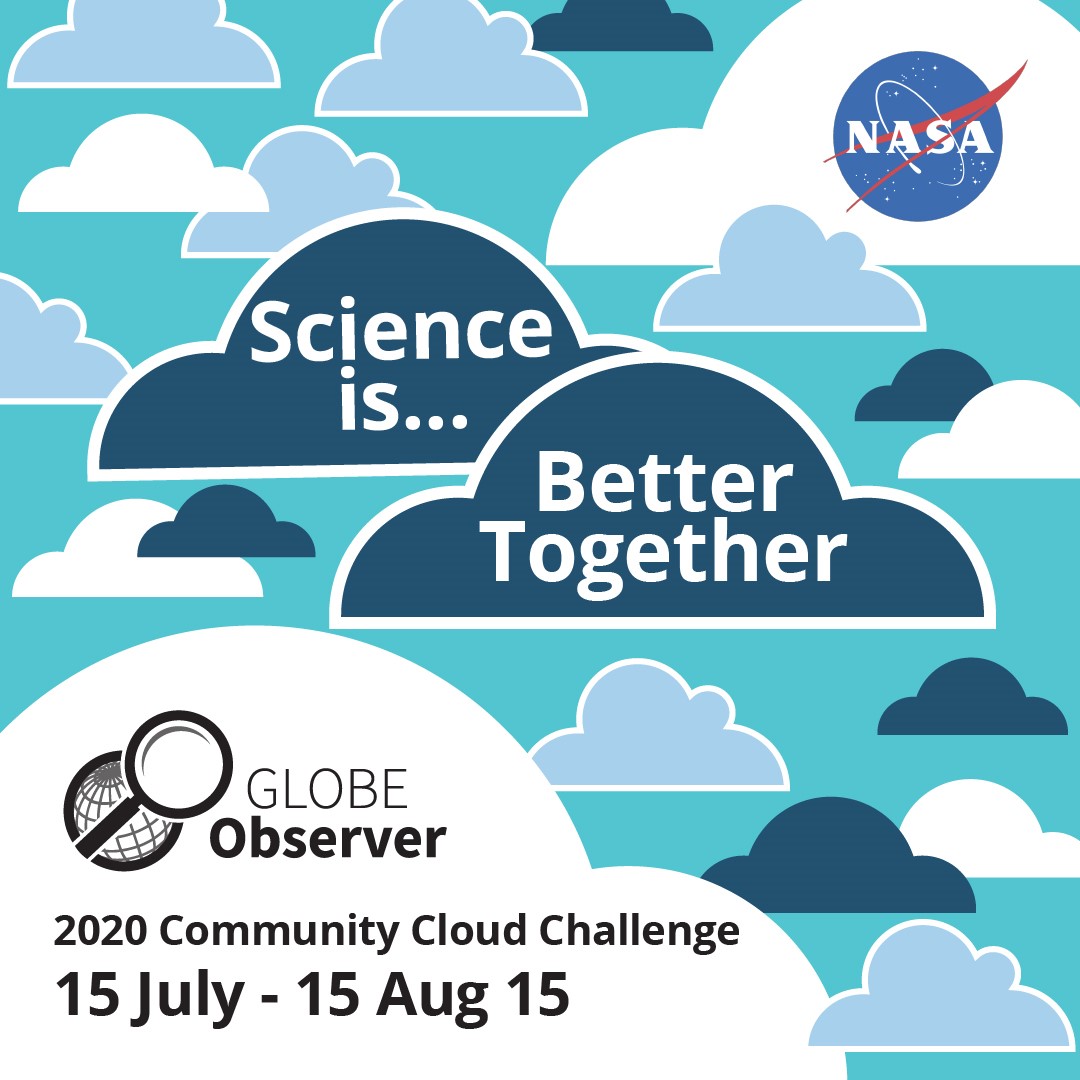GLOBE News
2020 Community Cloud Challenge Begins this Week (15 July)! Read NASA Press Release

This summer (or winter, if you live in the Southern Hemisphere) join GLOBE in the 2020 Community Cloud Challenge: Science is Better Together. The Community Cloud Challenge kicks off on 15 July 2020 and concludes on 15 August 2020.
Read the latest NASA Press Release (08 July):
Another partly cloudy day? We wouldn't have it any other way.
NASA and The GLOBE Program, an international science and education program that engages students and the public in data collection and the scientific process, are once again calling on citizen scientists around the world to turn their attention to the sky for the 2020 Community Cloud Challenge: Science Is Better Together, taking place July 15 through August 15.
We all share the same sky and the wide variety of clouds in it, so no matter where you are on Earth, there are ways you can participate in this year's challenge.
Past cloud challenges have taken the shape of a competition to see who could submit the most cloud observations. As has been the case with so many other things, though, COVID-19 is changing our approach in 2020. Rather than treating it as a competition this year, we’re asking you to participate in learning, observing, creating or engaging with GLOBE as a cloud observer. After all, when it comes right down to it, citizen science is just as much about engaging and learning about the science as it is about collecting data.
"Seeing the world like NASA researchers is what citizen science is all about,” says Marilé Colón Robles, lead for the GLOBE Clouds Team at NASA's Langley Research Center in Hampton, Virginia. “This summer we want everyone to choose their own adventures and discover clouds in a new way. Your perspective from the ground, looking up at clouds in your location, is a unique and important dataset. We want everyone to participate and learn more about their skies."
A recent paper by Langley researcher Brant Dodson showed good alignment between GLOBE cloud observations and different scientific-grade meteorology observations, including those taken during the 2017 North American solar eclipse. Dodson also found that observations from the two previous cloud challenges in spring 2018 and fall 2019 aligned extremely well with satellite data. In areas with partly cloudy conditions, ground observers and satellite data are in good agreement. In areas where the two aren't in agreement, it's often down to the advantage of perspective — GLOBE observers are looking up from the ground, seeing lower clouds, and satellites are looking down from space, seeing higher clouds. In either case, the extra observations from the ground are helping researchers get a more cohesive picture of what's happening in the sky, as they combine citizen science data from the ground with satellites above.
There are a variety of ways to be involved this time around, even if you're not in a participating GLOBE country, or if local conditions don’t allow you to safely get outside during the challenge period. Conduct experiments. Get creative with cloud art. Do cloud activities. Or watch and learn from a NASA scientist or science educator.
Use the GLOBE Observer Clouds Activity Tracker to record how many activities you try. Challenge your friends or build your own Cloud Observer community by trying activities together.
Beginning tomorrow and then weekly throughout the challenge, we'll be hosting Facebook Premier Watch Parties on the NASA Earth Facebook page. Each weekly video will showcase a NASA cloud expert and a demonstration that you can try at home. Our science mission experts and GLOBE team members will be on live to answer your cloud questions each week.
Also, be sure to follow The GLOBE Program on social media. And share what you're doing with us by using the hashtag #CloudChallenge. We want to see your pictures of clouds and your cloud activities. Tell us what your favorite clouds are, what you learned about clouds today or what got you interested in science in the first place.
Visit the GLOBE Observer website to download the app* and learn more about clouds and making observations.
Remember to always follow guidelines from your local officials, and only participate in GLOBE activities outside or use the GLOBE Observer app if it is safe to do so.
NASA sponsors The GLOBE Program, an international science and education program that provides students and the public with the opportunity to participate in data collection and the scientific process. NASA GLOBE Observer is a free smartphone app that lets anybody make several citizen science observations from the palm of their hand.
Joe Atkinson
NASA Langley Research Center
*only available in GLOBE participating countries
Also, read the latest GLOBE Community Blog, written by Marilé Colón Robles (lead for the GLOBE Clouds Team at NASA's Langley Research Center) providing details on how to participate, how to take cloud and sky observations, and more – just click here!
type: globe-newsNews origin: GLOBE Implementation Office





